5 Exercises To Foam Roll Your Glutes
This stretch can ease pain in your back and hips if you have tight glutes.
Medically reviewed by Amy Kwan, PT
Should you foam roll your glutes? This simple technique might help relieve sore and tight muscles. Simply sit on the foam roller, crossing one leg over the other. Massage your glutes by rolling back and forth over the muscle.
Foam rolling is a type of self-myofascial release (SMR); studies have shown that it may have short-term effects of increasing joint range of motion and reducing perceived pain after exercise. Read on to learn how to foam roll your glutes, including techniques and tips.
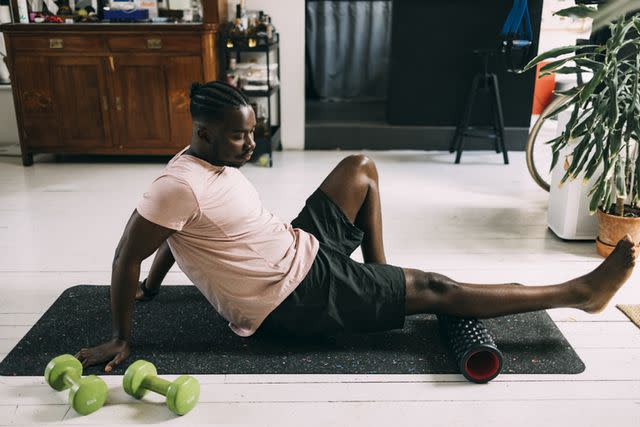
FreshSplash / Getty Images
Related: The 10 Best Resistance Bands for A Full Body Workout
Benefits of Foam Rolling
Many athletes use foam rolling to enhance their flexibility and muscular performance. Still, you do not have to play a sport to use this tool. For example, you might foam roll after a workout or a long day of sitting at your desk. Some evidence suggests that foam rolling helps reduce pain in people with hip osteoarthritis (OA), which causes wear and tear of the hip joint.
Other foam rolling benefits include:
Alleviates muscle pain and soreness
Decreases stress on your joints
Helps relax your muscles
Improves the range of motion in your joints
Is relaxing
Supports blood flow to your muscles
1. Glutes
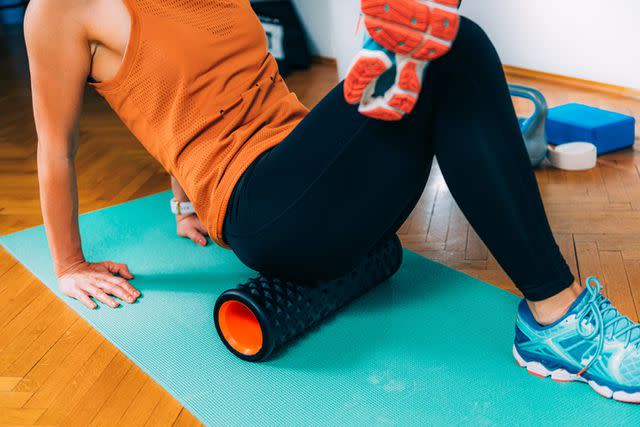
microgen / Getty Images
Your glutes are the muscles in your butt. There are three glute muscles: the gluteus maximus, gluteus medius, and gluteus minimus.
Your glutes help you move when you get up from sitting, straighten after bending, and while walking and running. You might want to roll out your glutes if you spend a lot of time sitting or doing aerobic exercises.
Sit on the foam roller. Reach your right arm behind you, placing your right hand on the ground for support.
Plant your left foot firmly on the ground, then cross your right ankle over your left knee.
Roll forward and backward for about one minute, then repeat on the opposite side.
2. Hamstrings
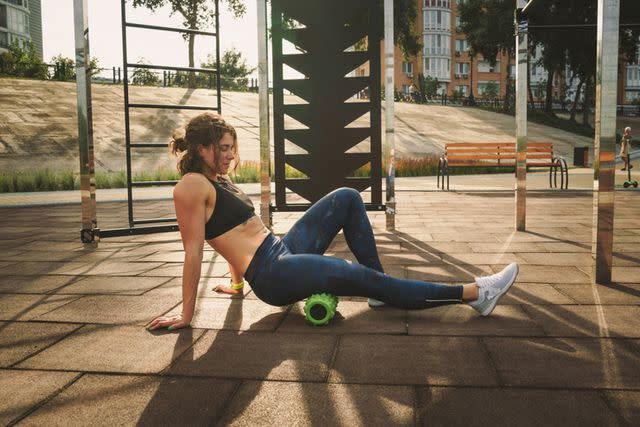
Yelizaveta Tomashevska / Getty Images
The hamstring muscles, found at the back of your legs, help move your legs. Your hamstrings connect to and support your gluteus maximus. Both muscles work to extend and rotate your hips.
People who do a lot of endurance exercise are likelier to get hamstring injuries than others. You might want to roll out your hamstrings if you spend much time biking or running.
Sit on the ground. Place the foam roller underneath your thighs, just below your glutes.
Reach your arms behind you, and place your hands on the ground for support.
Extend your right leg forward. Bend your left leg, planting your left foot on the ground for support.
Lift your upper body up off of the ground, then slowly roll forward and backward. Make sure that you target the entire area from the bottom of your glutes to the backs of your knees.
Continue for one minute, then repeat on the opposite side.
3. IT Band
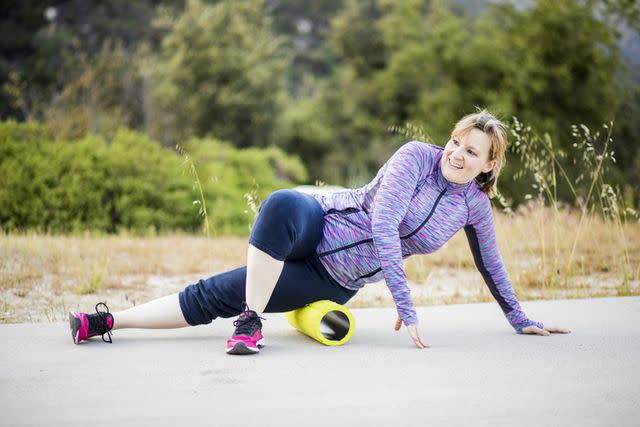
adamkaz / Getty Images
The iliotibial (IT) band is a long strip of connective tissue that extends from your outer hips to your outer knees. At your hips, the IT band connects to the gluteus maximus and gluteus medius. Those muscles work together to move your hips.
IT band tightness is common among people who regularly bike, skate, and run. Try foam rolling your IT band after aerobic exercise.
Lay sideways on the ground, then place the foam roller under your hip.
Plant your bottom forearm on the ground for support. Lift your feet off of the ground so that your hip makes contact with the foam roller at an angle.
Roll forward and backward, targeting the area from the bony part of your hip to your outer knee.
Roll for one minute, then repeat on the opposite side.
4. Lower Back
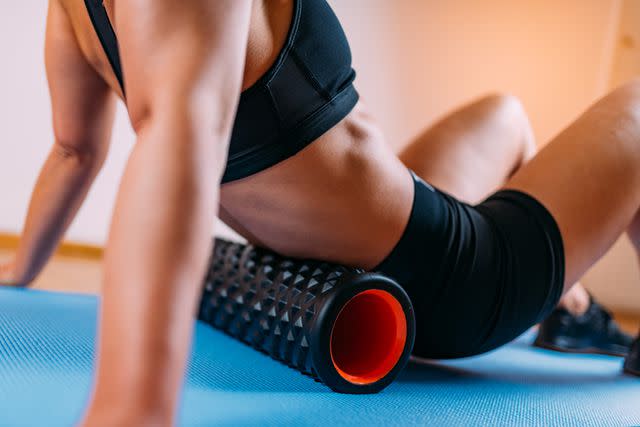
microgen / Getty Images
The connective tissue of the lower back connects to the gluteus maximus. Both work together to help support stability while you move.
Foam rolling your lower back might help alleviate pain in that area. People often develop lower back pain after lifting heavy items, playing sports, and stretching.
Place the foam roller under your lower back.
Extend your left leg forward, then pull your right knee to your chest.
Roll forward and backward from your lower back to your glutes.
Continue for one minute, then repeat on the opposite side.
5. Piriformis
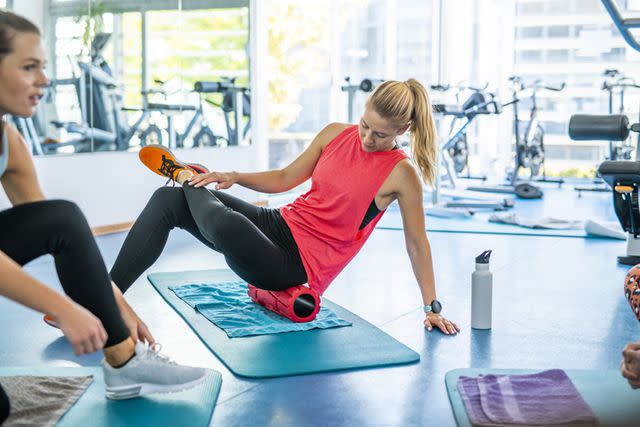
AzmanJaka / Getty Images
The piriformis, found underneath the gluteus maximus, is a small muscle that supports your movements. For example, the piriformis helps you transfer your weight from one foot to the other.
You might roll out the piriformis if you have pain from an injury, long periods of sitting, or too much physical activity. Talk to a healthcare provider before treating an injury with a foam roller.
Sit on the foam roller, placing both hands on the ground behind you.
Plant your left foot firmly on the ground, then cross your right ankle over your left knee.
Use short rolls over the middle of your right glutes. Move from side to side to roll out the entire muscle.
Continue for at least one minute, then repeat on the opposite side.
Risks
Foam rolling is usually safe, but some people may need to be cautious. Experts advise not foam rolling if you have a broken bone, muscle strain or tear, or open wound. The force of the foam roller might worsen existing injuries.
Talk to a healthcare provider before foam rolling if you have:
Deep vein thrombosis (DVT), or a blood clot that forms in a vein deep in your body and affects blood flow
Local tissue inflammation
Myositis ossificans, or what happens if bone forms in your muscles or tissues after an injury
Osteomyelitis, or a bone infection
Tips
Anyone can use a foam roller to alleviate muscle pain, improve range of motion, and stretch. Here are some tips for getting started:
Consider the texture: Some foam rollers are textured with ridges that help loosen up deep knots.
Ease discomfort: You might feel more pain when foam rolling over a particularly tight muscle. Try easing up the pressure, then lightly roll back and forth over the muscle. Gradually apply more pressure as your muscles adapt to the force and loosen up.
Pick your foam roller carefully: There are several shapes and sizes of foam roller that vary in firmness. You might opt for a long, cylindrical foam roller if you want to use it on your glutes. In contrast, a small, circular foam roller may work best for your neck and shoulders.
Test it out: Many gyms have foam rollers that you can try out before you purchase your own.
Try an online class: Check YouTube or workout apps for foam rolling routines that target specific body parts.
Related: The 9 Best Massage Guns of 2023, Tested and Reviewed
A Quick Review
Foam rolling helps increase your range of motion and reduce post-exercise pain and soreness, including your glutes. Foam rolling other muscles that attach to your glutes, such as your hamstrings and IT band, may support glute strength.
There are several types of foam rollers, ranging in shapes, sizes, and textures. Foam rolling might be unsafe if you have an injury, muscle strain or tear, or open wound. Talk to a healthcare provider before foam rolling if you have a health condition like DVT.
For more Health.com news, make sure to sign up for our newsletter!
Read the original article on Health.com.

